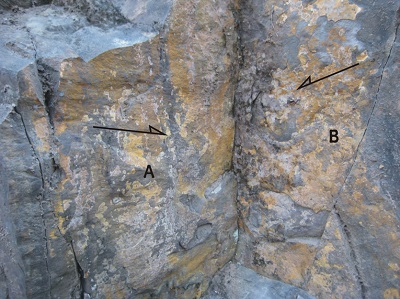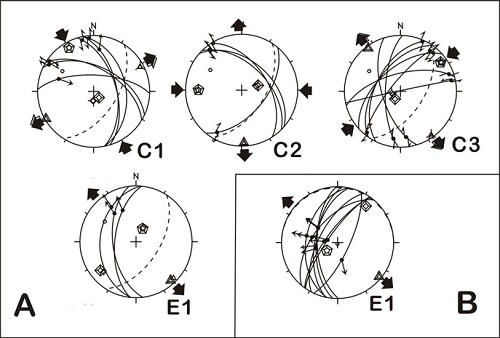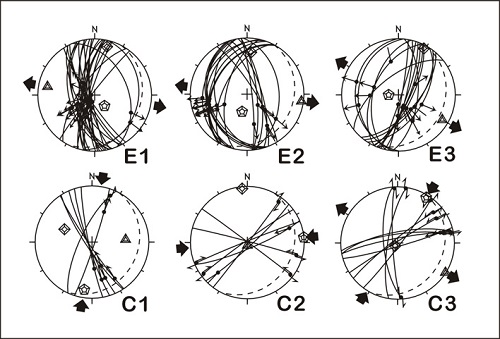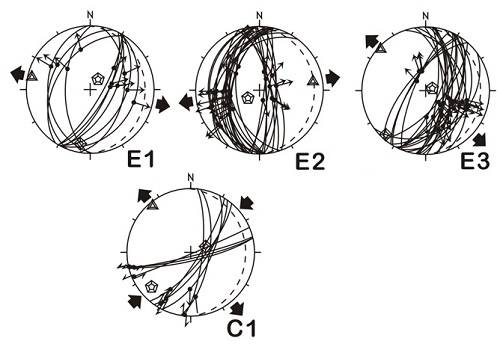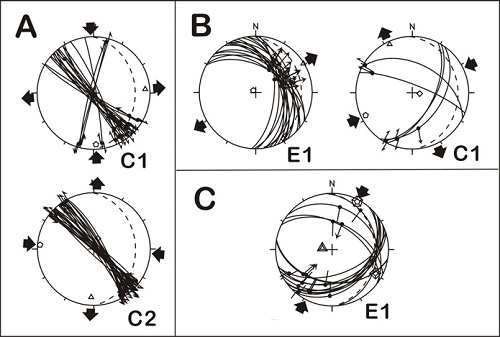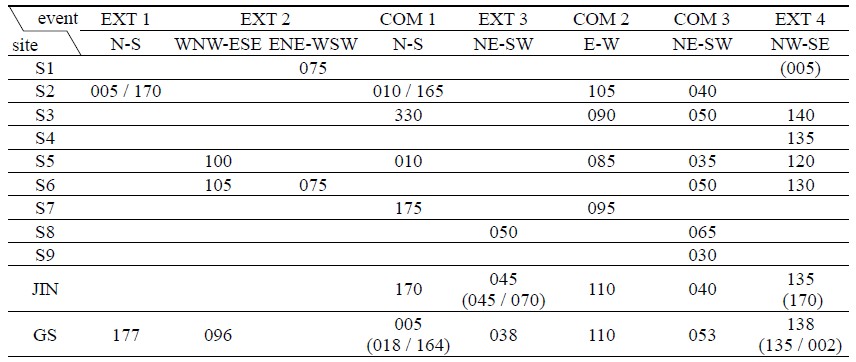
Tectonic deformation and paleostress reconstruction based on fault slip data in the Yongdong Basin
To gain a better understanding of the tectonic evolution of the Korean Peninsula, reconstitution of the paleostress field that occurred during the formation of Cretaceous sedimentary basins and during their tectonic deformation is a useful tool. It is especially useful for sedimentary basins that developed due to tectonic movement. Paleostress fields and tectonic deformational sequences of the Yongdong Basin have been reconstructed using minor fault populations. The tectonic sequence of the Basin is composed of four extensional and three compressional tectonic events and the sequence of the events are established mainly based on the relative chronology of minor fault movements. N-S extensional tectonic stress affected the early stages of the basin formation. This was followed by E-W extensional, N-S compression, NE-SW extensional, E-W compressional, NE-SW compressional and finally a NW-SE extensional tectonic regimes, respectively. This tectonic is in concurrence with those of the Gyeongsang and the Jinan basins.
초록
백악기 퇴적층들을 변형시킨 변형작용에 대한 고응력장을 복원하는 것은 한반도의 지구조 진화 환경을 이해할 수 있는 하나의 방법이다. 특히 분지의 발달이 지구조적 운동과 관련이 있다고 여겨지는 경우에는 매우 유용한 방법이 될 수 있다. 따라서 이번 연구에서는 옥천대 남중부의 백악기 소분지인 영동분지의 퇴적층에 발달하는 소단층 군집들을 이용해 고응력장을 복원하고 지구조운동사를 구성하여 보았다. 이를 통해 모두 4번의 인장응력기와 3개의 압축응력기가 확인되었고, 고기로 부터 남-북 인장응력기를 시작으로 동-서 인장응력기, 남-북 압축응력기, 북동-남서 인장응력기, 동-서 압축응력기, 북동-남서 압축응력기 그리고 북서-남동 인장응력기의 순서로 지구조운동사가 복원되었다. 이러한 지구조운동사는 같은 옥천대 남측 연변 구조분지인 진안분지뿐만 아니라 경상분지에서 복원되는 구조운동사와도 잘 일치되는 결과를 보여준다.
Keywords:
Paleostress field, Tectonic evolution, Yongdong Basin, Minor fault tectonics, Tectonic sequence, 고응력장, 지구조 진화, 영동분지, 소단층, 지구조운동사1. 서 언
영동분지의 지질구조와 퇴적상, 고지자기 등에 관한 연구는 여러 차례 이루어졌으며(Lee and Paik, 1990; Doh et al., 1996; Kim et al., 1997; Kim et al., 2000; Kim et al., 2002), 이러한 연구들을 통하여 분지의 발달과 진화에 관한 다양한 연구 결과가 제시되었다. 옥천습곡대의 남동쪽 경계와 북서쪽 경계는 모두 단층으로 규제되어 있으며, 따라서 풍암분지를 비롯하여 음성분지, 공주분지, 영동분지와 진안분지 등 백악기 소분지들은 모두 이 경계단층들의 규제를 받으면서 발달하고 있는 분포적 특징을 보여준다(Ryang, 2013). 따라서 이들 소분지의 지구조적 진화를 이해한다면 옥천대 경계단층의 진화과정을 이해하는데 도움을 줄 수 있을 것으로 판단된다.
영동분지 역시 옥천습곡대의 남동 경계에 발달하는 구조분지의 하나로(Hwang et al., 2001) 백악기 육성퇴적물로 충전되어 있다(Reedman and Um, 1975; Lee and Paik, 1990; Kim et al., 1997). 이 퇴적물들은 퇴적과 동시에 분지가 처해져 있던 고응력장에 반응하게 되고, 그 결과는 지구조 요소의 형태로 고화된 퇴적물에 남아 있게 된다. 이러한 지구조 요소들 가운데 취성 구조들을 이용하여 퇴적물이 겪었던 지구조운동을 복원할 수 있다(Huang and Angelier, 1989, Hwang and Angelier, 1992; Hwang, 1994; Chang and Baek, 1995; Moon et al., 2000; Choi et al., 2002; Chang et al., 2007; Hwang and Choi, 2012).
이 연구의 목적은 고응력장 복원의 방법으로 진안분지의 지구조 변형과 지구조운동사의 재구성을 통하여 경상분지의 그것들과 비교하였던 것(Hwang and Choi, 2012)과 같이 영동분지의 고응력장을 복원하여 분지 진화 과정에서 거쳤던 지구조운동사를 이해하고자 하는데 있다.
2. 영동분지의 지체구조적 위치와 분지의 진화
옥천습곡대 북서와 남동 경계 연변에 발달하는 여러 백악기 소분지들은 모두 지체구조 규모의 단층구조와 연관되어 있다(Lee and Paik, 1990; Lee, Y.U., 1992, 1999; Lee, H.K., 1998, 2010; Hwang et al., 2001; Ryang, 2013). 영동분지는 옥천습곡대의 중부 남동 경계부에 연하여 북동-남서향으로 대상의 형태를 가지며, 반지구성 분지(Chun et al., 1993; Kim et al., 1997; Kim et al., 2002)로 분지의 남동 경계는 단층으로 선캠브리아기 변성암류들과 접하고, 북서 경계는 부정합으로 선-백악기층들과 접한다(Shimamura, 1925; Kim and Hwang, 1986; Kim et al., 1997). 분지는 옥천습곡대의 중부 남동 경계부에 연하여 북동-남서향으로 대상의 형태를 가진다. 영동단층으로 불리는 선캠브리아 기반암과 영동분지 퇴적층 사이에 발달하는 단층의 운동감각은 좌수향 주향이동 운동성분이 강하게 나타난다. 영동단층은 영동분지의 진화와 밀접한 연관성을 가지며(Kim et al., 1997), 분지의 폐쇄 이후까지 단층운동을 지속하였던 것으로 해석된다(Lee and Paik, 1990).
분지 충전물은 대부분이 쇄설성 퇴적물이며, Lee and Paik (1990)은 분지 내 퇴적윤회 연구에 의해 분지가 진화하면서 퇴적중심도 북동방향으로 이동하여 감에 따라 퇴적물은 북동방향으로 중첩되어 간다고 하였다. 영동층군은 쇄설성 퇴적층으로 이루어지는 하부 층들과 달리 최상위에는 1매의 화산쇄설층이 수반된다(Shimamura, 1925; Son et al., 1969; Kim, 1974; Kim and Hwang, 1986; Lee et al., 1991; Choi et al., 1995; Kim et al., 1997). 층서 구분에는 각 연구자들에 따라 약간의 차이가 있기는 하나 대동소이하므로, 여기서는 Kim and Hwang (1986)의 1/5만 지질도에서 제시된 층서를 기본으로 하였다. 다만 복원된 고응력장과 분지 발달을 연계하여 해석하기 위하여 하부의 만계리층과 산이리층을 따로 분리하고, 그 상부의 동정리층과 백마산층과 선유동층, 원촌리층 그리고 명륜동층은 모두 하나의 층서 단위로 묶었다(그림 1). 이러한 구분은 퇴적상에 의한 퇴적윤회(Magasequences) 구분(Lee and Paik, 1990; Kim et al., 1997)과도 일치되고 있어 산이리층의 상부와 동정리층의 하부를 별도의 층서단위로 구분하여 영동층군을 대관하는데 용이하게 한다.
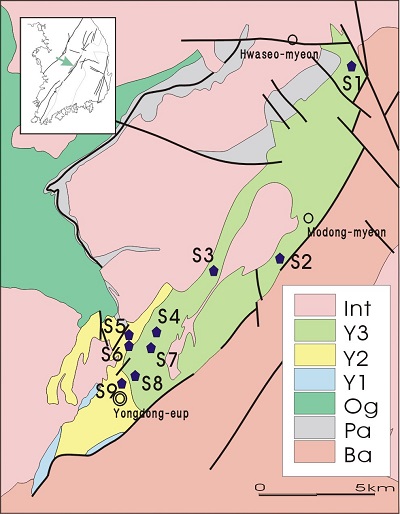
Geological map and studied sites. Small quadrangle shows location of the Yongdong Basin in southern half of Korean peninsular (based on the Geological maps of Andong and Daejeon Sheet 1/250,000). S1~S9: Selected sites for paleostress analysis. Ba: Baesment metasedimentary rocks. Pa: Paleozoic formations without Ogcheon Group. Og: Ogcheon Group. Y1: Mangyeri formation. Y2: Saniri Formation. Y3: Tongjongri Formation and Upper members of Yongdong Group. Int: Intrusives.
3. 단열구조
고응력장 복원에 사용된 구조요소들은 단층운동감각을 보여주는 소단층 군집들을 이용하였다. 모두 9개 조사지점(그림 1)에서 소단층 군집들이 측정되었으며, 단층운동과 층리변화의 상관관계를 알기 위하여 각각의 노두에서 대표적인 층리의 태위가 함께 측정되었다. 9개의 조사지점에서 획득된 지구조 요소들은 모두 492개이다. 그러나 각 조사지점의 특성에 따라 획득된 구조요소들의 수량은 편차가 심하다. 조사지점 S5나 S6의 경우 각각 100여개의 측정치를 가지고 있으나, S9의 경우는 모두 19개의 구조요소들만 획득되었다. 이러한 이유는 노두의 규모에 따라 측정될 수 있는 구조요소의 양이 좌우되고, 또 암석의 종류에 따라 단층구조요소의 발달이 크게 좌우되고 있기 때문이다. 비교적 사질암의 경우 소단층 군집의 보존이 양호하나, 입도가 크거나 세립질이 되면서 점차 보존이 불량한 경향을 보인다(그림 2). 특히 이질암의 경우는 보존되고 있는 취성구조요소를 찾아보기 어렵다.
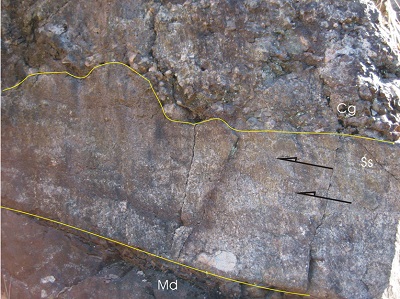
Fault striations are well developed on fine sandy rocks more so than within the coarser grained rocks. Arrows mean fault striations. Cg: Conglomerate. Ss: Sandstone and Pebbly sandstone. Md: Mudstone.
획득된 소단층 군집들은 각각 주향이동단층과 정단층, 역단층 운동감각을 가진다. 대부분 단일 단층면에서는 하나의 단층운동 감각이 인지되나, 경우에 따라 복수의 단층운동 감각을 보여주는 곳도 있다. 이러한 경우는 단층면의 재활성을 지시하는 것으로, 서로 다른 단층면이 교차하는(그림 3) 단층면의 절단관계 등과 더불어 단층운동에 대한 상대적인 순위가 확인될 수 있으므로 복원되는 고응력장의 상대적인 순서를 통해 구조운동사 복원에 아주 유익하게 활용할 수 있다.
4. 고응력장 복원
조사지점별로 획득한 소단층 군집을 이용하여 응력텐서를 구하고 여기에서 최대, 최소 응력축 방향을 복원하였다. 여기서는 Choi (1991)의 “DAGUR”와 “ASI”를 주로 사용하였으며, 복원 결과의 대비를 위하여 참고로 Angelier (1983)의 “R4DT” 방법도 함께 사용되었다. 이러한 방법들은 모두 Anderson (1942)과 Bott (1959)의 이론에 근거한 것으로 국내에서는 주로 경상분지의 고응력장 해석에 많이 적용되었다(Hwang and Angelier, 1992; Hwang, 1994; Chang and Baek, 1995; Moon et al., 2000; Choi et al., 2002; Chang et al., 2007; Hwang and Choi, 2012). 그러나 고기 암석의 분포지에서도 시도된 바 있으며(Kim et al., 1992), 특정단열구조의 변형사에 대한 해석에도 응용된 바(Kim et al., 1992; Chae and Chang, 1994; Lee and Hwang, 1997; Chang and Chang, 1998; Choi et al., 2002) 있다.
각 조사지점에서 획득한 492개 지구조 요소들 가운데 100여개는 고응력장 해석에 활용되지 못하였다. 기하학적으로 해석이 불가능했던 것들은 획득 과정에서의 측정오류도 있을 수 있으나, 대부분 통계학적으로 해석하기 위한 충분한 모집단이 되지 않았기 때문이다. 따라서 이번에는 확인되지 못했더라도 어떤 지구조적 사건을 지시하는 것은 분명할 것이다. 앞으로 더 정밀한 연구가 수행된다면 이들이 의미하는 새로운 지구조 사건도 밝힐 수 있을 것으로 생각된다.
조사지점 S1에서 2회의 인장응력기가 복원되었다(그림 4). 층리의 경사는 10o 내외로 저각이기 때문에 층리를 복원하여도 응력축들의 배치는 크게 변화하지 않는다. 조사지점 S2에서는 모두 6회의 지구조사건이 복원되는데, 층리의 경사가 65o 내외로 고각이므로 이를 반영하여 복원된 응력기는 모두 2회의 인장응력기와 4회의 압축응력기로 나누어진다(그림 5). 조사지점 S3도 층리가 55o 내외로 고각도를 보인다. 이 지점에서는 3회의 압축응력기와 1회의 인장응력기가(그림 6A), 그리고 층리의 경사가 10도 이내인 S4에서는 1회의 인장응력기가 복원되었다(그림 6B). 그림 7은 조사지점 S5로 층리의 경사는 15o 내외이고 복원된 고응력장은 3회의 인장응력기와 3회의 압축응력기를 보여주며, 그림 8은 조사지점 S6에서 복원된 3회의 인장응력기와 1회의 압축응력기를 보여주고 있으며, 이 지점에서의 층리의 경사는 약 20o 내외의 저각을 이룬다. 조사지점 S7과 S8, S9에서 복원된 고응력장은 각각 2회의 압축응력기(그림 9A), 1회의 압축응력기와 1회의 인장응력기(그림 9B), 그리고 1회의 인장응력기(그림 9C)가 확인되었으며, 이 지점들의 층리는 대략 20o 내외의 경사를 보이고 있다.

Analysis of minor fault population of the site S1. Diagrams show tectonic events as extensional events (E*). Diagrams marked E*R are reconstituted diagram with dip angle of the bedding plane. Symbols: pentagon, square and triangle mean maximum, intermediate and minimum stress axes respectively. Solid and single symbols of stress axes are calculated using “DAGUR” and “ASI” methods (see text). A dotted line is projection along bedding planes.
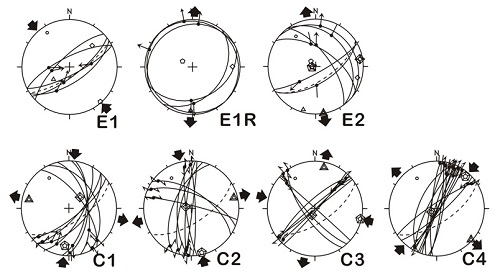
Analysis of minor fault population a t site S2.Diagrams show tectonic events as extensional (E) and compressional (C) events, respectively. Diagram E1R is reconstituted diagram E1 with dip angle of the bedding plane. Others are the same as Fig. 4.
5. 고응력장 해석
조사지점 S2는 지층이 고경사를 이루고 있어 복원된 고응력축의 배치와 층리변화의 상관관계를 검토하여야 한다. 그 결과 역단층 군집들에 의해 북서-남동 방향의 압축응력기를 지시하는 것과 같이 보이는 E1 구조운동기는, 복원된 3개의 응력축 방향이 층리 복원 후 더 이론적인 배치에 가깝게 변화되는 것으로 보아 층리의 경동 이전에 있었던 남-북 방향의 인장응력장 하에서 만들어진 정단층군(그림 5, E1R)으로 해석하였다. 그러나 층리의 경사와 관련이 없는 것으로 보이는 남-북 방향의 인장응력기를 지시하는 소단층 군집들이 같이 확인되고 있어(그림 5, E2), 약간의 차이가 있을 수는 있겠으나 대략 남-북 방향의 인장응력기는 층리의 경동 이전에서부터 시작하여 상당한 기간 동안 계속되었음을 지시하고 있다고 해석된다. 또 여기서는 층리의 경사 전과 후의 시간적 차이는 있으나 대략 남-북 방향의 압축응력기(그림 5, C1, C2)가 확인되고 있는데 이들도 이미 층리의 경동이 어느 정도 진행된 이후에 있었던 응력장으로 해석되는데, 층리의 경동이 완료된 이후에 있었던 서북서-동남동향(그림 5, C3)과 북동-남서향(그림 5, C4)의 압축응력기와는 분명히 구분된다.
그림 6A는 S3 지점에서 복원된 3개의 압축응력기와 한 개의 인장응력기를 보여준다. 고각도의 층리 경사각을 가지는 이 지점은 4개의 응력기들이 모두 이미 층리의 경동이 진행된 이후에 있었던 응력장을 지시하고 있어 S2 지점과 같이 남-북 압축응력기 이전에 지층의 경동이 이루어졌다는 해석이 가능해 진다. 이 가운데 북서-남동 방향의 인장응력기를 지시하는 E1은 단지 3개의 단층자료에 의해 얻어진 결과로 신뢰도는 매우 낮다. 그러나 이와 동일한 응력기가 타 지점에서 잘 관찰되고 있어 동일한 의미를 가진다고 해석하여도 크게 무리가 없을 것으로 생각한다.
S5 지점에서 복원된 3개의 인장응력기 가운데 E3를 제외한 두 개의 인장응력기 E1과 E2(그림 7)는 동일한 응력장을 지시하는 것으로 최대응력축방향에 약간의 변화가 있음을 알려준다. 이러한 변화는 경상분지에서 전반적으로 잘 나타나며(Hwang, 1994), 곳에 따라서는 최소응력축방향에도 다소간에 변화를 보여주어 조사지점 S6에서처럼 마치 별개의 응력기를 나타내는 것으로 해석되기도 한다(그림 8, E1과 E2).
6. 구조운동사
조사지점의 노두와 고응력장 해석과정에서 얻어진 선후관계를 이용하여 지구조운동기들의 상대운동사를 수립하였고, 표 1과 같은 구조운동사를 얻었다. 두 번의 인장응력기(EXT 1, 2)에 이어 순서대로 COM 1, EXT 3, COM 2, COM 3 그리고 마지막으로 EXT 4가 확인되며, 이러한 구조운동사는 경상분지(GS)와 진안분지(JIN)의 구조운동사와도 잘 일치하고 있다(표 1).

Correlation of tectonic sequences of the Yongdong Basin with those of the Jinan and the Gyeongsang Basins. EXT: extensional tectonic event. COM: compressional tectonic event. JIN: Jinan Basin (Hwang and Choi, 2012). GS: Gyeongsang Basin (Hwang, 1994).
조사지점 S1에서 E2 인장응력기는 남-북향의 인장응력을 지시하고 있다. 노두에서 층리의 경사가 급하지 않아 층리의 경동이 응력축 방향을 변화시킬 가능성이 낮아 이를 통해 응력기의 상대시기를 결정하기는 어렵다. 그러나 이 노두는 영동층군의 하부층준에 해당하지 않는 동정리층으로 분대되고 있는 지역이므로, 이 남-북향의 인장응력기가 경상분지에서 나타나는(표 1) 것과 같이 분지 발달 초기에 나타나는 응력기와 대비하기는 어려울 것이므로 운동사적인 증거는 없으나 분지 발달 후기인 EXT 4에 대비된다고 해석하였다.
조사지점 S2는 영동층군의 명륜동층에 해당하는 지역으로, 명륜동층은 분지의 발달과 긴밀한 관련이 있는 영동단층과 연하여 발달하는 선상지 퇴적층으로 영동분지 발달의 초기로부터 오랜 진화과정을 거치는 퇴적층이다(Kim and Hwang, 1986). 따라서 명륜동층의 하위층준은 분지 발달의 초기 응력상태를 기록하고 있을 가능성이 높다. 이러한 관점에서 S2에서 확인되는 두 번의 남-북 방향의 인장응력기 중 지층의 경사 이전의 인장응력기는 영동분지 초기의 응력장을 지시하고 있을 가능성이 높으며, 경상분지에서 나타나는(표 1) 것과 같이 분지 발달 초기에 나타나는 응력기와 대비될 수 있을 것으로 볼 수 있다(EXT 1). 반면 지층의 경동 이후 남-북 방향의 인장응력기(그림 5, E2)는 영동분지 지구조사의 후기에 대비되는 인장응력기일 가능성이 높다고 해석할 수 있다. 그러나 노두에서 관찰되는 소단층들의 상호선후관계에 의하면 이 인장응력기가 남북방향의 압축응력기(그림 5, C1)에 앞서는 것으로 확인되고 있어, 이 두 번째 인장응력기도 역시 최초의 인장응력기(그림 5, E1)와 동일한 응력장을 지시하는 EXT 1에 대비되는 것으로 해석되었다.
S3 지점에서 확인되는 상대 구조운동사는 노두에서 확인되는 소단층들의 상관관계에서 북서-남동 인장응력기(그림 6A, E1)는 북동-남서 압축응력기(그림 6A, C3)보다 후기임이 확인되고 있다. 다만 여기서 북서-남동 압축응력기(그림 6A, C1)는 표 1에서 보여주는 바와 같이 COM 1 그룹의 일반적인 남-북 압축응력과는 최소응력축 방향에서 상당한 차이가 있다. 그러나 다른 압축응력기(COM 2, COM 3)의 최대응력축 방향과도 확연히 구분되고 있어, COM 1에 대비되는 것으로 생각하였고, 이러한 응력축 방향변화의 원인은 국부적이고 일시적인 응력장의 왜곡에 기인하는 것으로 추정된다.
S5 지점과 S6에서 대략 동-서향을 지시하는 인장응력기는 모두 노두에서 남-북, 북동-남서향의 압축응력기에 앞서는 것으로 확인되어 경상분지의 구조운동사와 같은 결과를 보여준다. 다만 이 두 지점 노두의 고응력 해석과정에서 분리된 소단층 군집들의 상호관계를 고려하면 모두 북서-남동향의 인장응력기가 남-북 압축응력기보다 앞서는 것으로 나타나고 있어, 경상분지(Hwang, 1994)와 진안분지(Hwang and Choi, 2012)에서의 결과와 다소 다른 순서를 보여준다. 이러한 결과는 자료 취득의 오류에 기인할 수 있고, E3(그림 6, 7)를 지시하는 구조요소들로 분리된 것들 중 일부가 E1 혹은 E2기에 발달한 것이거나, 이들이 E3기의 구조요소로 오인되었을 가능성도 있어 이에 대해서는 더 정밀한 연구가 요구된다.
7. 토 의
조사지점 S1에서 복원된 응력축 방향의 배치를 검토하여 보면 E2에서는 중간응력축이 단층군집의 교점과 일치되는데 반해 E1에서는 최대응력축이 교점과 일치되고 있다(그림 4). 이로 미루어 지구조 사건 E1기는 횡압력에 의한 압축응력보다는 인장응력이 우세하게 작용하였던 시기로 해석할 수 있다. 또 조사지점 S2 노두에서 역단층으로 나타난 E1R의 정단층군들이 모두 저각을 이루고 있어 최대응력축과의 축간각이 크게 나타나는데, 이러한 현상도 이 시기에는 횡압력이나 수직압축응력보다 수평인장응력이 더 주도적으로 작용하였던 것으로 생각되며, 이는 분지의 전개를 주도하던 응력장 환경을 시사하는 것으로 해석할 수 있을 것이다. Ryang (2013)의 연구 결과에서도 영동분지는 횡압축보다는 횡인장 분지로 분류하고 있어 이러한 가능성을 지지한다고 할 수 있다. 이러한 저각의 정단층은 일반적인 공액단층에서 볼 수 있는 경우와는 차이가 있으나, 인장력이 주도적으로 작용하는 응력환경에서 발달할 수 있는데(Ferrill et al., 1998; Ferrill and Morris, 2003; Zheng et al., 2004) 영동분지 초기 퇴적물에 충분한 암석화가 진행되지 못한 상태에서 지속적인 인장응력이 가해지면서 약하지만 연성변형이 결합된 취성변형이 발생하였을 가능성을 추론해볼 수 있다.
명륜동층에 위치하는 조사지점 S2를 제외하면 영동분지와 진안분지에서는 경상분지에서 볼 수 있는 최초 인장응력기가 나타나지 않는다. 이것은 옥천대 남부 경계를 이루는 구조선 -영동, 진안분지를 형성하는 지구조선- 의 활동시기가 경상분지의 분지 전개 시기보다 늦을 가능성을 시사하고 있다. 물론 이번 연구에서 영동층군의 하부층인 만계리층에서는 단층자료를 수집하지 못하여 최하위 구조운동기가 누락되었을 가능성도 없지는 않다. 또 옥천대 연변의 다른 백악기 소분지인 음성분지의 연구 결과(Chun et al., 1994)와 같이 영동분지에서도 산출된 개형충과 윤조류 미화석에 의한 고생물연구를 통하여 영동분지 퇴적 시기를 경상분지의 신동층군과 하양층군에 대비시키는 연구결과(Choi et al., 1995)도 있고, 영동분지 퇴적층의 생층서 대비에 의해 퇴적 시기를 보다 고기로 보는 연구 결과(Chun et al., 1993)도 있다. 이러한 연구 결과들은 진안분지의 지구조운동 시기(Hwang and Choi, 2012)와는 달리 영동분지의 구조운동은 경상분지의 전개와 시기를 같이할 가능성을 보여준다 할 수 있다. 만계리층의 분포가 극히 제한적이지만 앞으로 만계리층에 대한 연구가 더 이루어질 수 있다면 이러한 의문도 해결될 수 있을 것이다.
8. 결 론
영동분지에 발달하는 소단층 군집들을 이용하여 고응력장을 복원하여 보았다. 모두 4번의 인장응력기와 3번의 압축응력기가 복원되었으며, 지구조운동사를 수립하여 보면 오래된 순서대로 남-북 인장응력기를 시작으로 동-서 인장응력기, 남-북 압축응력기, 북동-남서 인장응력기, 동-서 압축응력기, 북동-남서 압축응력기 그리고 북서-남동 인장응력기로 이루어진다. 이러한 지구조운동사는 같은 옥천대 남측 연변 구조분지인 진안분지에서 복원된 운동사와도 일부 일치되며, 경상분지에서 복원되는 구조운동사와도 잘 일치되는 결과이다.
Acknowledgments
이 논문은 한국지질자원연구원의 도폭지질조사 사업 수행 과정에서 이루어진 연구 결과이며, 이 논문을 위하여 많은 도움을 주신 최성자 박사, 김유봉 박사께 감사드린다. 아울러 논문의 질을 향상시킬 수 있도록 꼼꼼하게 검토하여주신 이희권 교수, 손문 교수 두 분의 심사위원 그리고 편집위원 김영석 교수와 편집위원장께 심심한 사의를 표하고자 한다.
References
- E.M Anderson,, The dynamic of faulting, Oliver and Boyd. Edinburgh, (1942), p191.
- J Angelier,, Anslyses qualitative et quantitative des populations de jeux de failles, Bulletin of the Society of Geology of France, (1983), 7, p661--672, (in France).
-
M.H.P Bott,, The mechanics of oblique slip faulting, Geology Magazine, XCVI-2, (1959), p109-117.
[https://doi.org/10.1017/S0016756800059987]

- B.G. Chae,, T.W Chang,, Movement history of the Yangsan Fault and its related fractures at Chongha-Yongdok area, Korea, Journal of the Geological Society of Korea, (1994), 30, p379-394, (in Korean with English abstract).
- C.J. Chang,, T.W Chang,, Movement history of the Yangsan Fault based on paleostress analysis, Journal of Engineering Geology, (1998), 8, p35-49, (in English with Korean abstract).
- T.W. Chang,, Y Baek,, Tectonic movement of the Tertiary Basin between Kyungju and Eoil, Korea, Journal of the Geological Society of Korea, (1995), 31, p200-214, (in English with Korean abstract).
- T.W. Chang,, J.H. Jeong,, C.J Chang,, Tectonics of the Tertiary Eoil and Waeup basins in the southeastern part of Korea, Journal of Engineering Geology, (2007), 17, p27-40, (in Korean with English abstract).
- P.Y Choi,, Method for determining the stress tensor using fault slip data, Journal of the Geological Society of Korean, (1991), 27, p383-393, (in Korean with English abstract).
- P.Y. Choi,, C.B. Lee,, C.R. Ryoo,, Y.S. Choi,, J.Y. Kim,, H.J. Hyun,, Y.S. Kim,, J.Y Kim,, U.C Chwae,, Geometric analysis of the Quaternary Malbang fault: Interpretation of borehole and surface data, Journal of the Geological Society of Korea, (2002), 38, p163-174, (in Korean with English abstract).
- P.Y. Choi,, C.R. Ryoo,, S.K. Kwon,, U.C. Chwae,, J.H. Hwang,, S.R. Lee,, B.J Lee,, Fault tectonic analysis of the Pohang-Ulsan area, SE Korea: Implications for active tectonics, Journal of the Geological Society of Korean, (2002), 38, p33-50, (in Korean with English abstract).
- S.J. Choi,, B.C. Kim,, H.Y. Chun,, Y.B Kim,, Charophytes from the Chopyeong Formation (Cretaceous) of the Eumsung Basin, Korea, Journal of the Geological Society of Korea, (1995), 31, p523-528, (in Korean with English abstract).
- S.J. Choi,, Y.B. Kim,, B.C Kim,, Stratigraphy and paleontology of the Cretaceous sedimentary strata in the Yongdong Basin, Report KR-95 (C)-1, Korea institute of geology, mining and materials, Taejon, (1995), p118, (in Korean with English abstract).
- H.Y. Chun,, Y.S. Choi, S.J. Choi,, Y.B. Kim,, B.C. Kim,, B.J. Lee,, P.Y Bong,, Fossil floral and faunal assemblage and paleoenvironmental modelling study on the Cretaceous sedimentary basin scattered in/near the Ogcheon Belt (II), Report KR-94 (T)-11, Korea Institute of geology, mining and materials, Taejon, (1994), p101, (in Korean with English abstract).
- H.Y. Chun,, S.H. Um,, S.J. Choi,, Y.B. Kim,, B.C. Kim,, Y.S Choi, Fossil floral and faunal assemblage and paleoenvironmental modelling study on the Cretaceous sedimentary basin scattered in/near the Ogcheon Belt (I), Report KR-93 (T)-11, Korea Institute of geology, mining and materials, Taejon, (1993), p122, (in Korean with English abstract).
- S.J. Doh,, Y.Y. Cho,, D Suk,, Remagnetization of the Cretaceous sedimentary rocks in the Yeongdong Basin, Economic and environmental geology, (1996), 29, p193-206, (in Korean with English abstract).
-
D.A. Ferrill,, A.P Morris,, Dilatation normal faults, Journal of Structural Geology, (2003), 25, p183-196.
[https://doi.org/10.1016/S0191-8141(02)00029-9]

-
D.A. Ferrill,, A.P. Morris,, S.M. Jones,, J.A Stamatakos,, Extensional layer-parallel shear and normal fault, Journal of Structural Geology, (1998), 20, p355-362.
[https://doi.org/10.1016/S0191-8141(97)00090-4]

-
Q. Huang,, J Angelier,, Inversion of field data in fault tectonics to obtain the regional stress -II. Using conjugate fault sets within heterogeneous families for computing paleostress axes, Geophysic Journal, (1989), 96, p139-149.
[https://doi.org/10.1111/j.1365-246X.1989.tb05256.x]

- J.H Hwang,, Reconstitution of paleostress in the southeastern Korean Peninsula since the Early Cretaceous, Journal of the Geological Society of Korea, (1994), 30, p27-34, (in Korean with English abstract).
- J.H. Hwang,, J Angelier,, Paleostress reconstructions and the tectonic evolution of the Kyungsang Basin: a case example near Goryeong-eub, Journal of the Geological Society of Korea, (1992), 28, p471-482, (in English with Korean abstract).
- J.H. Hwang,, P Choi,, Tectonic deformation and sequence of the Jinan Basin, Journal of the Geological Society of Korea, (2012), 48, p241-248, (in Korean with English abstract).
- J.H. Hwang,, M.S. Jin,, M.S. Jun,, J.D. Cho,, S.R. Lee,, S.B. Koo,, P.Y. Choi,, Y.S. Lee,, B.C. Kim,, J.W. Kim,, W.S. Kee,, P.C. Kang,, K.Y. Song,, J.H. Kim,, S.R. Lee,, T.W Chang,, Tectonic map of Korea, KIGAM, (2001.).
-
B.C. Kim,, K.M. Yu,, H.Y. Chun,, S.J. Choi,, Y.B Kim,, The southeastern margin of the Cretaceous Yongdong Basin, Korea: a lacustrine fan-delta system, Geoscience Journal, (1997), 1, p61-74.
[https://doi.org/10.1007/BF02910478]

- H.M Kim,, Paleocurrent analysis of the Yongdong Group, southern Korea, Journal of the Geological Society of Korea, (1974), 10, p1-24, (in English with Korean abstract).
- J.H. Kim,, Y.L. Lee,, K.H. Nam,, P.-Y Choi,, Paleostress analysis within the thrust zone, Yeongchun, the Danyang Coalfield, Korea, Journal of the Geological Society of Korea, (1992), 28, p184-195, (in English with Korean abstract).
- J.S. Kim,, S.H. Han,, C.W. Rhee,, B.C. Kim,, W.H. Ryang,, H. Shon,, Y.K Sohn,, Electrical resistivity and seismic reflection mapping for the southeastern part of the Yongdong basin (Cretaceous), Korea, Journal of the Korean Geophysical Society, (2000), 3, p77-90, (in English with Korean abstract).
- J.S. Kim,, S.H. Han,, C.W. Rhee,, B.C. Kim,, W.H Ryang,, Surface geophysical surveys the northern part of the Yongdong basin (Cretaceous), Korea, Journal of the Korean Geophysical Society, (2002), 5, p329-336, (in Korean with English abstract).
- K.B. Kim,, J.H Hwang,, Geological report of the Yongdong sheet (1:50,000), Korea institute of energy and resources, Seoul, (1986), p44, (in Korean with English abstract).
- B.J. Lee,, J.H Hwang,, Relationship between the Kaum fault and the Yangsan fault at the northeastern part of the Cretaceous Kyongsang Basin, Journal of the Geological Society of Korea, (1997), 33, p1-8.
- D.W. Lee,, J.H. Chi,, K.C Lee, Stratigraphy of the strike-slip fault-controlled Yongdong Basin, Korea: A genetic study in the northern part of the basin, Journal of the Geological Society of Korea, (1991), 27, p246-258, (in English with Korean abstract).
- D.W. Lee,, K.H Paik,, Evolution of strike-slip fault controlled Cretaceous Yongdong Basin, South Korea: signs of strike-slip tectonics during infilling, Journal of the Geological Society of Korea, (1990), 26, p257-276, (in English with Korean abstract).
- H.K Lee,, Structural analysis of the Cretaceous Pungam Basin, Journal of the Geological Society of Korean, (1998), 34, p122-136, (in Korean with English abstract).
- H.K Lee,, Structural features of the Keumwang fault zone at Sangnam-myon, Inje-gun, Gangwon-do, Journal of the Geological Society of Korea, (2010), 46, p561-576, (in Korean with English abstract).
- Y.U Lee,, Stratigraphy, depositional environment and evolution of the Cretaceous Chinan Basin, Ph.D. thesis, Seoul National University, Seoul, (1992), p287, (in Korean with English abstract).
- Y.U Lee,, An analysis of the energy for the elevation of the Cretaceous Jinan Basin, Journal of the Korean Earth Science Society, (1999), 20, p437-443, (in Korean with English abstract).
- T.H. Moon,, M. Son,, T.W Chang,, I.S Kim,, Paleostress reconstruction in the Tertiary basin area in Southeastern Korea, Journal of the Korean Earth Science Society, (2000), 21, p230-249, (in Korean with English abstract).
- A.J. Reedman,, S.H Um,, The geology of Korea, Korea institute of Energy and Resources, (1975), p139.
- W.H Ryang, Characteristics of strike-slip basin formation and sedimentary fills and the Cretaceous small basins of the Korean Peninsula, Journal of the Geological Society of Korea, (2013), 49, p31-45, (in Korean with English abstract).
- S Shimamura,, Geological map of Chosen, Yongdong and Cheongsan Sheet (1:50,000), Geological survey of Chosen, (1925), (in Japanese with English abstract).
- C.M. Son,, C.H. Cheong,, S.M. Lee,, S.H Um,, A study on the sedimentary environment and geological structure of Korea, Research report of Ministry of Science and Technology, (1969), (in Korean with English abstract).
-
Y. Zheng,, T. Wang,, M. Ma,, G.A Davis,, Maximum effective moment criterion and the origin of low-angle normal faults, Journal of Structural Geology, (2004), 26, p271-286.
[https://doi.org/10.1016/S0191-8141(03)00079-8]

